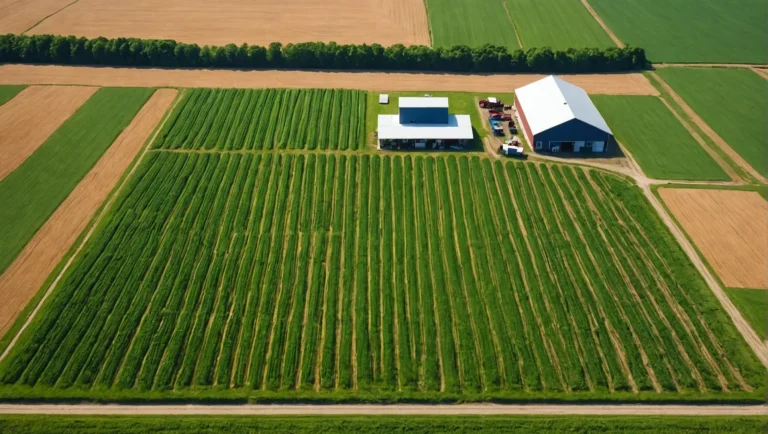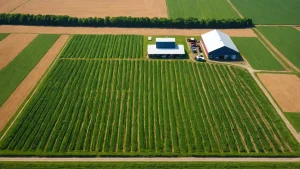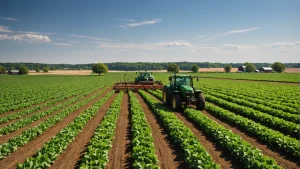Are you struggling to maximize your farm’s efficiency and profitability in 2024? You’re not alone. Many farm business owners face the same challenge of optimizing their farm layout to boost productivity and streamline operations.
But what if I told you that by implementing proven farm layout strategies, you could unlock the full potential of your farm business? In this article, we’ll dive into 15 game-changing techniques that will help you plan your farm layout for maximum efficiency.
From conducting thorough site analysis to harnessing the power of farm management software, we’ve got you covered. Get ready to transform your farm’s layout and take your business to new heights in 2024.

Metrobi has been a game changer for farm industry.
With Metrobi, you can save 23% on delivery costs, save 80% of the time from managing deliveries, and delight your customers with delivery notifications & tracking.
Maximize Your Farm’s Efficiency with These Proven Layout Planning Strategies (Such as Stardew Valley Farm Layout)
Conduct A Thorough Site Analysis
Before you begin planning your farm layout, it’s essential to conduct a comprehensive site analysis. This process involves assessing the quality of your soil, evaluating water resources, and examining the topography of your land. By understanding these key factors, you can make informed decisions about crop placement, irrigation systems, and infrastructure development. If you’re figuring out how to allocate resources efficiently, explore the fundamentals of creating a farm budget to enhance your agricultural planning.
Start by collecting soil samples from various locations on your farm and send them to a local agricultural extension office for testing. The results will provide valuable insights into the nutrient content, pH levels, and overall health of your soil. This information will guide you in selecting the most suitable crops for each area of your farm. According to the United States Department of Agriculture (USDA), soil testing is a crucial step in determining the nutrient requirements of your crops.
Next, assess your water resources. Identify the location of wells, streams, or other water sources on your property. Determine the quality and quantity of water available, as this will impact your irrigation plans and the types of crops you can grow. If necessary, consider investing in water storage solutions, such as tanks or reservoirs, to ensure a consistent supply throughout the growing season. The Environmental Protection Agency (EPA) provides guidelines for water conservation and management in agriculture.
Finally, examine the topography of your land. There are different kinds of farms, such as beach farm, meadowlands farm, corners farm, riverland farm, wilderness farm, etc. Note any slopes, hills, or low-lying areas that may affect drainage, erosion, and accessibility. This information will be crucial when deciding on field layouts, road placement, and building locations. The National Oceanic and Atmospheric Administration (NOAA) offers resources on topographic mapping and land use planning.
Create A Detailed Farm Map
Armed with the data from your site analysis, it’s time to create a detailed map of your farm. This map will serve as the foundation for your layout planning and help you visualize the relationships between different areas of the forest farm and other elements of your operation.
Start by using GPS or drone technology to create an accurate base map of your property. Include all existing buildings, roads, and natural features such as rivers, forests, or wetlands. If you don’t have access to these technologies, you can also use satellite imagery or hand-drawn sketches as a starting point. The United States Geological Survey (USGS) provides satellite imagery and mapping resources for agricultural planning.
Once you have your base map, divide it into zones based on intended use. Create separate areas for crops, livestock, storage, processing, and other key functions of your farm. Consider the relationships between these zones and how they will impact the flow of materials, equipment, and personnel.
Optimize Field Layouts For Efficient Farm Maps Design
With your farm map in hand, it’s time to optimize your field layouts for maximum efficiency. One effective strategy is to arrange your fields in a grid pattern, with evenly spaced rows and consistent spacing between crops. This layout makes it easier to navigate equipment, monitor crop health, and perform maintenance tasks. Research by the University of Illinois suggests that grid-based field layouts can improve crop yields and reduce fuel consumption.
When deciding on crop placement, group plants with similar requirements together. For example, place crops that require similar amounts of water, fertilizer, or sunlight in the same area. This approach streamlines your management practices and reduces the risk of over- or under-applying inputs.
If your farm includes sloped land, consider incorporating contour farming techniques to reduce erosion and improve water retention. Plant crops along the contours of the land, following the natural curves of the terrain. This practice helps to slow down water runoff and minimize soil loss, leading to healthier crops and more sustainable land management. The National Resources Conservation Service (NRCS) guides contour farming and soil conservation.
Streamline Workflow With Strategic Building Placement
In addition to optimizing your field layouts, strategic building placement can significantly improve your farm’s efficiency. Position barns, storage facilities, and processing areas near the fields they serve to minimize travel distances and reduce the time spent moving materials and equipment.
When deciding on building locations, consider the natural flow of your operations. Place structures in a logical sequence that follows the progression of your products from field to storage to processing. This approach reduces bottlenecks and improves the overall efficiency of your workflow. The American Society of Agricultural and Biological Engineers (ASABE) offers resources on farm building design and layout.
As your farm business grows, be prepared to adapt your layouts to accommodate new equipment, crops, animals, or other features or production methods. Plan for future expansion by leaving space for additional buildings or fields, and be willing to make changes as needed to maintain peak efficiency.

Delivery notifications and tracking improve customer satisfaction by 27%.
Metrobi automatically notifies your receivers of ETAs, provides delivery tracking, and collects delivery feedback.
Boost Farm Business Productivity with These Layout Optimization Techniques
Implement precision agriculture technologies to optimize input use and improve efficiency
Incorporate lean farming principles to eliminate waste and establish efficient systems
Continuously improve layouts based on data and feedback for maximum productivity
Implement Precision Agriculture Technologies
In today’s competitive farming landscape, precision agriculture technologies play a crucial role in optimizing farm layouts and boosting productivity. By leveraging GPS-guided equipment, farmers can achieve precise planting, spraying, and harvesting, ensuring that each plot of land is utilized to its fullest potential. This technology allows for accurate spacing between rows and plants, reducing waste and increasing yield per acre.
According to the United States Department of Agriculture, precision agriculture can increase crop yields by up to 20% and reduce water usage by up to 30%.
Another key aspect of precision agriculture is the adoption of variable rate applications. This technique involves adjusting the application of inputs such as fertilizers, pesticides, and water based on the specific needs of each area within a field. By using data from soil sensors and other monitoring devices, farmers can create detailed maps of their land and apply inputs accordingly. This targeted approach not only saves resources but also improves crop quality and reduces environmental impact.
A study by the International Society for Precision Agriculture found that variable rate application can reduce fertilizer usage by up to 15% and pesticide usage by up to 20%.
Incorporate Lean Farming Principles
Lean farming is a management approach that focuses on identifying and eliminating waste in all aspects of farm operations. By streamlining processes and optimizing resources, farmers can improve efficiency and reduce costs. One key aspect of lean farming is establishing efficient storage and inventory management systems. This involves organizing tools, equipment, and supplies in a way that minimizes unnecessary movement and ensures easy access when needed.
According to the Lean Farming Institute, efficient storage and inventory management can reduce waste by up to 20% and improve productivity by up to 15%.
Another critical component of lean farming is continuous improvement. Farmers should regularly review their layouts and processes, seeking opportunities to eliminate bottlenecks and improve workflow. This can involve rearranging equipment, optimizing storage locations, or implementing new technologies. By fostering a culture of continuous improvement, farmers can adapt to changing market conditions and stay ahead of the competition.
To effectively optimize farm layouts, it’s essential to collect and analyze data from various sources. This can include yield maps, soil tests, weather patterns, and financial records. By integrating this information into a comprehensive farm management system, farmers can identify areas for improvement and make data-driven decisions about layout changes.
For example, if yield maps reveal that certain areas of a field consistently underperform, farmers can investigate the underlying causes and make targeted adjustments. This might involve adjusting drainage patterns, amending soil nutrients, or changing crop rotations. By continuously monitoring and refining layouts based on data and feedback, farmers can maximize productivity and profitability over time. A study by the Agricultural and Applied Economics Association found that data-driven layout optimization can improve crop yields by up to 12% and reduce costs by up to 10%.
By implementing precision agriculture technologies and incorporating lean farming principles, farm businesses can optimize their layouts for maximum productivity. These strategies not only improve efficiency but also contribute to more sustainable and profitable operations in the long run.
Harness the Power of Farm Management Software for Layout Planning
Farm management software has revolutionized the way farmers plan and optimize their farm layouts. By leveraging these powerful tools, you can create detailed farm maps, analyze spatial data, and simulate different layout scenarios to assess their impact on efficiency. This technology enables you to make informed decisions that will help you maximize productivity and profitability.
Utilize GIS-Based Farm Management Software
Geographic Information System (GIS) technology has become an essential tool for modern farm management. GIS-based software allows you to create detailed maps of your farm, including topography, soil types, and existing infrastructure. By analyzing this spatial data, you can identify areas that are best suited for specific crops or livestock, optimize irrigation and drainage systems, and plan for future expansions.
One of the key benefits of using GIS-based software is the ability to simulate different layout scenarios. You can experiment with various crop rotations, planting patterns, and infrastructure placements to determine which options will yield the best results. This virtual testing can save you time and resources by helping you avoid costly mistakes and ensuring that your farm layout is optimized for maximum efficiency.
To further enhance the effectiveness of your farm management software, consider integrating it with precision agriculture technologies. These tools, such as GPS-guided tractors, variable rate applicators, and remote sensing devices, can provide real-time data on crop health, soil conditions, and weather patterns. By combining this information with your GIS-based software, you can create a seamless operation that optimizes resource allocation and minimizes waste.
Drone imagery for crop monitoring
Soil moisture sensors for irrigation management
Yield mapping for identifying high and low-performing areas
Collaborate With Agribusiness Consultants and Extension Services
While farm management software is a powerful tool, it’s important to recognize that it’s not a replacement for human expertise. To ensure that you’re making the most of these technologies, consider collaborating with agribusiness consultants and extension services.
Agribusiness consultants can provide valuable insights into optimizing your farm layout based on your specific needs and goals. They can help you identify areas where you can improve efficiency, reduce costs, and increase profitability. Additionally, they can guide in selecting the right farm management software and precision agriculture technologies for your operation.
Extension services, often affiliated with universities or government agencies, offer a wealth of knowledge and resources for farmers. Many extension programs host workshops and training sessions on farm business optimization, including topics such as layout planning and technology adoption. By attending these events, you can learn from experts in the field and network with other farmers who may have valuable experiences to share.
In addition to in-person collaboration, don’t overlook the value of online forums and communities. Many farm management software providers host user forums where farmers can share their experiences, ask questions, and learn from one another. These communities can be a great resource for troubleshooting issues, discovering new features, and staying up-to-date on the latest trends in farm management technology.
AgTalk: A popular forum for farmers and ranchers
Precision Farming Dealer: A community focused on precision agriculture technologies
Farm Business Network: A network of farmers sharing data and insights to improve profitability
By leveraging the power of farm management software and collaborating with experts in the field, you can create a farm layout that maximizes efficiency and sets your business up for long-term success.
Understanding the Basics of Farm Business Structures
Sole Proprietorship
A sole proprietorship is the simplest and most common business structure for small farms. Under this structure, the farmer has complete control and responsibility for the business, including all profits, losses, and liabilities. One of the main advantages of a sole proprietorship is its simplicity – there are no complex legal or tax filings required, and the farmer can make decisions quickly and efficiently.
However, a significant drawback of a sole proprietorship is that the farmer’s assets are not separated from the farm assets. This means that if the farm is sued or falls into debt, the farmer’s personal assets, such as their home or savings, could be at risk. Additionally, sole proprietorships may face challenges when trying to raise capital or secure loans, as lenders may view the business as less stable than other structures.
In a sole proprietorship, the farm’s income and expenses are reported on the farmer’s personal tax return, using Schedule F (Form 1040). This means that the farm’s profits are taxed at the farmer’s individual income tax rate, which can be higher than the rates for other business structures. However, sole proprietorships may be eligible for certain tax deductions, such as the home office deduction or the self-employment tax deduction.
Partnership
A partnership is a business structure in which two or more individuals share ownership and management of the farm. Partners share profits, losses, and decision-making responsibilities according to the terms of their partnership agreement. Partnerships can be an attractive option for farmers who want to pool their resources and expertise to create a stronger, more competitive business.
One of the main benefits of a partnership is that it allows for a division of labor and specialization among the partners. For example, one partner may focus on crop production while another handles marketing and sales. Partnerships can also provide a built-in support system, as partners can lean on each other during challenging times.
However, partnerships also come with some risks and challenges. Disagreements among partners can lead to conflict and potentially even the dissolution of the business. Additionally, partners are personally liable for the debts and obligations of the rest of the partnership, which means their personal assets could be at risk if the farm falls into financial trouble.
To minimize the risks associated with partnerships, it is essential to create a formal partnership agreement that clearly defines the roles, responsibilities, and expectations of each partner. The agreement should also outline how profits and losses will be shared, how decisions will be made, and what will happen if a partner wants to leave the business.
Limited Liability Company (LLC)
A Limited Liability Company (LLC) is a business structure that offers personal asset protection and tax advantages. Under an LLC, the farm is considered a separate legal entity from its owners, which means that the owner’s assets are typically not at risk if the farm is sued or falls into debt.
Another advantage of an LLC is its flexibility in terms of management structure and ownership options. LLCs can be created and managed by the owners themselves or by hired managers, and ownership can be divided among multiple individuals or even other businesses.
However, LLCs do require more formal record-keeping and reporting than sole proprietorships. In most states, LLCs must file annual reports and pay annual fees to maintain their status. Additionally, LLCs may face higher administrative costs than other business structures, such as the cost of hiring an attorney to draft the LLC operating agreement.
One of the most significant advantages of an LLC is its tax treatment. By default, an LLC is taxed as a pass-through entity, which means that the farm’s profits and losses are passed through to the owners’ tax returns. This can result in significant tax savings compared to other business structures, such as corporations.
Cooperative
A cooperative is a business structure that is owned and controlled by its members, who are typically the farmers themselves. In a cooperative, members pool their resources and share in the profits and losses of the business. Cooperatives can be an attractive option for farmers who want to work together to achieve economies of scale, access new markets, or share the costs of expensive equipment or infrastructure.
One of the main advantages of a cooperative is that it allows farmers to maintain their independence while still benefiting from the collective strength of other farms in the group. Cooperatives can also provide members with access to specialized services, such as marketing or technical support, that they might not be able to afford on their own.
However, cooperatives also come with some challenges. Decision-making can be more complex in a cooperative, as each member has an equal say in the business. Additionally, cooperatives may face challenges in raising capital, as traditional lenders may be hesitant to lend to a business with multiple owners.
Corporation
A corporation is a business structure that is owned by shareholders and managed by a board of directors. Corporations offer the highest level of personal asset protection, as the corporation is considered a separate legal entity from its owners. This means that shareholders’ assets are typically not at risk if the corporation is sued or falls into debt.
Another advantage of a corporation is its ability to raise capital through the sale of stock. This can be particularly useful for farms that require significant investments in land, equipment, or infrastructure.
However, corporations also come with some drawbacks. They are subject to more extensive record-keeping and reporting requirements than other business structures, and they may face higher administrative costs, such as the cost of holding annual meetings and maintaining corporate records. Additionally, corporations are subject to “double taxation,” as the corporation’s profits are taxed at the corporate level and then again when dividends are paid out to shareholders.
There are two main types of corporations: S corporations and C corporations. The main difference between the two is how they are taxed.
S corporations are pass-through entities, which means that the corporation’s profits and losses are passed through to the shareholders’ personal tax returns. This can result in significant tax savings compared to C corporations, which are subject to double taxation.
C corporations, on the other hand, are taxed as separate entities from their shareholders. This means that the corporation’s profits are taxed at the corporate level, and then shareholders are taxed again on any dividends they receive. However, C corporations may be able to take advantage of lower corporate tax rates and other tax benefits that are not available to S corporations.
Key Factors to Consider When Choosing a Farm Business Structure
Liability Protection
When choosing a farm business structure, it’s crucial to assess the level of risk associated with your operations. Some structures, such as sole proprietorships and partnerships, offer little to no personal asset protection. In the farming space, by contrast, limited liability companies (LLCs) and corporations provide a layer of protection between your personal assets and the farm’s liabilities. Explore methods for securing dependable seasonal employees to ensure your farm’s operations are efficiently managed.
Tax Implications
Different farm business structures have varying tax implications. Sole proprietorships, partnerships, and LLCs (default classification) are considered pass-through entities, meaning the business’s income and losses are reported on the owners’ personal tax returns. In contrast, corporations are subject to corporate taxation, which can result in double taxation of profits.
Pass-through taxation can be advantageous for many farm businesses, as it allows profits and losses to be reported directly on the owners’ personal tax returns. This can result in a lower overall tax burden, especially for farms that are just starting out or have fluctuating income.
Corporate taxation may be more suitable for larger, established farms with consistent profits. While double taxation can be a drawback, corporations offer greater flexibility in terms of ownership structure and employee benefits.
Management and Succession Planning
When selecting a farm business structure, it’s essential to evaluate your long-term goals and vision for the farm. In the beginning, you should have water access. Some structures, such as partnerships and LLCs, offer greater flexibility in terms of management and decision-making. Others, like corporations, have more formal management structures and can facilitate smoother ownership transitions.
By carefully considering liability protection, tax implications, and management and succession planning, farm owners can choose a business structure that sets them up for long-term success. Consulting with legal and tax professionals can help ensure that the chosen structure aligns with the farm’s unique needs and goals.
Maximizing Farm Efficiency through Sustainable Practices
Transitioning from choosing the right farm business structure to implementing sustainable practices is crucial for maximizing efficiency and ensuring long-term success. By adopting eco-friendly methods, farmers can reduce input costs, improve soil health, and minimize their environmental impact. Let’s explore three key strategies for achieving these goals.
Implement Conservation Tillage Methods
Conservation tillage is a farming practice that aims to reduce sandy soil disturbance and erosion by minimizing the amount of tillage performed. This approach offers several benefits for farm efficiency and sustainability.
By leaving crop residue on the soil surface, conservation tillage helps protect the soil from wind and water erosion. This is particularly important in areas prone to heavy rainfall or strong winds. Minimizing soil disturbance also helps maintain soil structure, which improves water infiltration and reduces runoff.
Conservation tillage promotes the buildup of organic matter in the soil, which enhances soil health and fertility. Increased organic matter improves soil structure, allowing for better water retention and drainage. This, in turn, can lead to higher crop yields and reduced need for irrigation, saving both water and energy costs.
To implement conservation tillage:
Assess your current tillage practices and identify areas for improvement
Invest in suitable equipment, such as no-till planters or strip-till rigs
Gradually reduce tillage intensity over time, allowing the soil to adjust
Monitor soil health and crop performance, making adjustments as needed
Adopt Integrated Pest Management (IPM) Strategies
Integrated pest management is a holistic approach to controlling pests and diseases in crops. By combining various control methods, IPM aims to reduce reliance on chemical pesticides while maintaining crop health and yield.
The first step in IPM is to regularly monitor pest populations in your fields. This can be done through scouting, trapping, or using technology like drone imagery. Once you have identified the type and extent of pest infestation, you can select the most appropriate control method.
Targeted control methods may include:
Biological control: Using natural predators or parasites to control pest populations
Cultural control: Adjusting planting dates, crop rotation, or sanitation practices to reduce pest pressure
Mechanical control: Using physical barriers, traps, or vacuuming to remove pests
Chemical control: Applying pesticides only when necessary and using the least toxic option available
By using a combination of control methods, IPM helps reduce the need for chemical pesticides. This not only saves money on input costs but also promotes the growth of beneficial insects and reduces the risk of pesticide resistance developing in pest populations.
To adopt IPM on your farm:
Educate yourself and your staff on IPM principles and practices
Establish a regular scouting and monitoring routine for your crops
Identify the economic threshold for each pest species in your area
Implement a variety of control methods, prioritizing non-chemical options
Keep detailed records of pest populations, control measures used, and crop yields
Incorporate Cover Cropping and Crop Rotation
Cover cropping and crop rotation are two essential practices for improving soil health, reducing erosion, and sustainably managing pests and diseases.
Cover crops are planted between main crop seasons to protect and enrich the soil. They help prevent erosion, suppress weeds, and add organic matter to the soil when they are terminated and incorporated into the soil.
Common cover crops include:
Legumes: Clover, vetch, and peas, which fix nitrogen in the soil
Grasses: Rye, oats, and sorghum, which produce large amounts of biomass
Brassicas: Radishes and turnips, which can help break up compacted soil
To incorporate cover crops into your farming system:
Identify the main objectives for your cover crop (e.g., nitrogen fixation, weed suppression)
Select cover crop species that are well-suited to your climate and soil type
Determine the best time to plant and terminate the cover crop based on your main crop rotation
Use appropriate equipment to plant and manage the cover crop, such as a no-till drill or roller-crimper
Crop rotation involves planting different types of crops in a field each season or year. By alternating plant families, farmers can disrupt the life cycles of pests and diseases that are specific to certain crops. This helps reduce the need for chemical inputs and improves overall crop health.
To develop an effective crop rotation plan:
Group crops into families based on their susceptibility to common pests and diseases
Alternate between crop families in each field, ensuring that the same family is not grown in consecutive seasons
Include cover crops and fallow periods in the rotation to further break pest and disease cycles
Keep accurate records of crop rotations for each field to ensure proper planning
By implementing these sustainable practices – conservation tillage, integrated pest management, cover cropping, and crop rotation – farmers can maximize the efficiency of their operations while reducing their environmental impact. Adopting these strategies may require an initial investment in time and resources, but the long-term benefits for soil health, crop productivity, and profitability make it a worthwhile endeavor.
Elevate Your Farm’s Efficiency and Profitability in 2024
Optimizing your farm layout is a critical step toward achieving maximum efficiency and profitability. By conducting thorough site analysis, creating detailed maps, and implementing precision agriculture technologies, you can streamline your operations and boost productivity. Learn essential strategies for optimizing your agricultural practices in our guide, “Managing Your Farm: Essential Tips for Success.”
Adopting sustainable practices like conservation tillage, integrated pest management, and cover cropping not only reduces input costs but also promotes soil health and long-term viability.
As you plan for the future of your farm business, consider the advantages and implications of different business structures. Seek expert advice and choose a structure that aligns with your goals and provides the necessary liability protection and tax benefits.
Ready to take your farm to the next level? Start by assessing your standard farm buildings current layout and identifying areas for improvement. Which layout strategies and sustainable practices can you implement this season to increase efficiency and profitability?



























